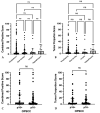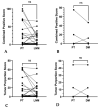Standardized Digital Image Analysis of PD-L1 Expression in Head and Neck Squamous Cell Carcinoma Reveals Intra- and Inter-Sample Heterogeneity with Therapeutic Implications
- PMID: 38893222
- PMCID: PMC11171694
- DOI: 10.3390/cancers16112103
Standardized Digital Image Analysis of PD-L1 Expression in Head and Neck Squamous Cell Carcinoma Reveals Intra- and Inter-Sample Heterogeneity with Therapeutic Implications
Abstract
For practical reasons, in many studies PD-L1 expression is measured by combined positive score (CPS) from a single tumor sample. This does not reflect the heterogeneity of PD-L1 expression in head and neck squamous cell carcinoma (HNSCC). We investigated the extent and relevance of PD-L1 expression heterogeneity in HNSCC analyzing primary tumors and recurrences (LRs), as well as metastases. Tumor tissue from 200 HNSCC patients was immunohistochemically stained for PD-L1 and analyzed using image-analysis software QuPath v3.4 with multiple specimens per patient. CPS was ≥20 in 25.6% of primary tumors. Intra-tumoral heterogeneity led to a therapeutically relevant underestimation of PD-L1 expression in 28.7% of patients, when only one specimen per patient was analyzed. Inter-tumoral differences in PD-L1 expression between primary tumors and lymph node metastasis (LNM) or LR occurred in 44.4% and 61.5% (CPS) and in 40.6% and 50% of cases (TPS). Overall survival was increased in patients with CPS ≥ 1 vs. CPS < 1 in primary tumors and LNM (hazard ratio: 0.46 and 0.35; p < 0.005); CPS in LR was not prognostic. Our analysis shows clinically relevant intra- and inter-sample heterogeneity of PD-L1 expression in HNSCC. To account for heterogeneity and improve patient selection for immunotherapy, multiple sample analyses should be performed, particularly in patients with CPS/TPS < 1.
Keywords: HPV; biomarker; combined positivity score (CPS); head and neck squamous cell carcinoma (HNSCC); heterogeneity; oropharyngeal squamous cell carcinoma (OPSCC); p16; prognosis; programmed cell death 1 Ligand 1 (PD-L1); tumor proportion score (TPS).
Conflict of interest statement
The authors declare no conflicts of interest.
Figures











Similar articles
-
Evaluation of programmed death ligand 1 expression in cytology to determine eligibility for immune checkpoint inhibitor therapy in patients with head and neck squamous cell carcinoma.Cancer Cytopathol. 2022 Feb;130(2):110-119. doi: 10.1002/cncy.22501. Epub 2021 Aug 10. Cancer Cytopathol. 2022. PMID: 34375025 Free PMC article.
-
Comparison of three PD-L1 immunohistochemical assays in head and neck squamous cell carcinoma (HNSCC).Mod Pathol. 2021 Jun;34(6):1125-1132. doi: 10.1038/s41379-020-0644-7. Epub 2020 Aug 5. Mod Pathol. 2021. PMID: 32759978
-
The clinicopathological significance of PD-L1 expression assessed by the combined positive score (CPS) in head and neck squamous cell carcinoma.Pathol Res Pract. 2022 Aug;236:153934. doi: 10.1016/j.prp.2022.153934. Epub 2022 May 4. Pathol Res Pract. 2022. PMID: 35691098
-
PD-L1 evaluation in head and neck squamous cell carcinoma: Insights regarding specimens, heterogeneity and therapy.Pathol Res Pract. 2021 Oct;226:153605. doi: 10.1016/j.prp.2021.153605. Epub 2021 Sep 1. Pathol Res Pract. 2021. PMID: 34530257 Review.
-
The different role of PD-L1 in head and neck squamous cell carcinomas: A meta-analysis.Pathol Res Pract. 2020 Jan;216(1):152768. doi: 10.1016/j.prp.2019.152768. Epub 2019 Nov 28. Pathol Res Pract. 2020. PMID: 31837884 Review.
References
-
- Lacas B., Carmel A., Landais C., Wong S.J., Licitra L., Tobias J.S., Burtness B., Ghi M.G., Cohen E.E.W., Grau C., et al. Meta-analysis of chemotherapy in head and neck cancer (MACH-NC): An update on 107 randomized trials and 19,805 patients, on behalf of MACH-NC Group. Radiother. Oncol. 2021;156:281–293. doi: 10.1016/j.radonc.2021.01.013. - DOI - PMC - PubMed
Grants and funding
LinkOut - more resources
Full Text Sources
Research Materials

